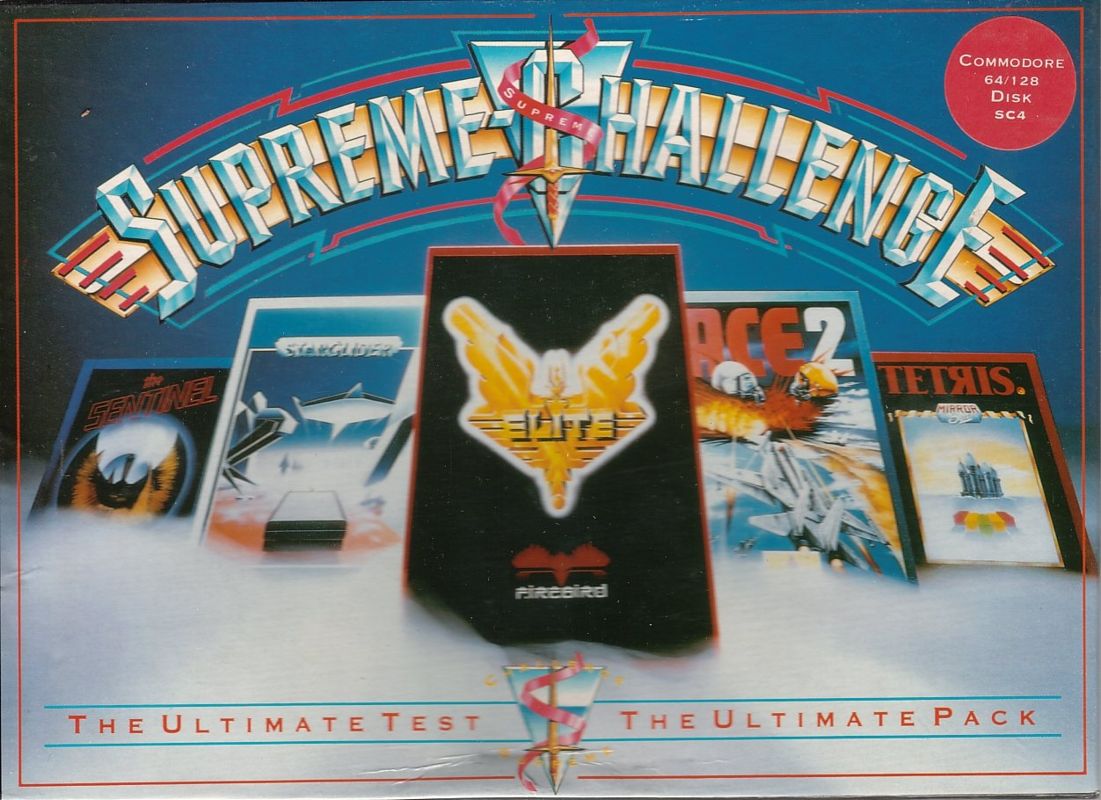Retro Replay Review
Gameplay
Supreme Challenge brings together five distinct classics—Starglider, Elite, The Sentinel, Tetris: The Soviet Challenge, and ACE 2—each offering a unique gameplay loop that showcases the evolution of 1980s and early 1990s interactive design. Starglider dazzles with its breakneck, wireframe-based space combat, pitting you against waves of alien fighters. The controls are tight yet approachable, making dogfights feel both frantic and rewarding. Whether you’re strafing through asteroid fields or lining up the perfect shot on a mothership, its blistering pace remains a joy to pilot even decades later.
(HEY YOU!! We hope you enjoy! We try not to run ads. So basically, this is a very expensive hobby running this site. Please consider joining us for updates, forums, and more. Network w/ us to make some cash or friends while retro gaming, and you can win some free retro games for posting. Okay, carry on 👍)
Elite’s open-world sandbox is a masterclass in emergent gameplay. You begin as a lowly miner with a kickboard and a laser cannon and gradually rise through the ranks of galactic traders, bounty hunters, and pirates. The freedom to chart your course—buy low, sell high, accept missions or engage in duels—creates a sense of ownership rarely matched in modern titles. Its steep learning curve may intimidate newcomers, but the payoff of amassing credits, upgrading your Cobra Mk. III, and tackling ever-tougher foes is immensely satisfying.
The Sentinel shifts gears entirely, offering a cerebral puzzle experience. You rotate around geometric landscapes, absorbing energy cubes, defending against rising sentinel towers, and planning each move carefully. There’s a beautiful tension in calculating the next absorption point or deciding whether to rebalance your energy stores—mistakes here can undo minutes of progress. Its slow, methodical pace contrasts sharply with the high-octane thrills of the space sims, demonstrating the compilation’s breadth.
Rounding out the package, Tetris: The Soviet Challenge delivers the addictive, tile-matching formula that has captivated generations, while ACE 2 revs up the realism with mission-based flight simulation. Tetris remains instantly accessible yet endlessly deep, challenging you to maintain control as pieces stack ever higher. ACE 2’s flight experience is considerably more technical: realistic avionics, cocktail of weapon loadouts, and weather effects combine to create a simulator that demands patience and precision. Together, these five titles showcase an impressive spectrum of gameplay, from action to strategy to pure arcade fun.
Graphics
While Supreme Challenge maintains the original pixel aesthetics of each title, it supplements them with optional upscaling filters and adjustable resolutions. Starglider’s wireframe polygons appear cleaner than ever, with crisp lines that pop against a star-studded void. You can switch between authentic low-res mode for nostalgia or a filtered view that smooths edges and enhances contrast, breathing new life into this pioneering 3D shooter.
Elite’s stark, vector-based starfields and minimalist cockpit display have been lovingly preserved, evoking that unmistakable retro-futuristic charm. The compilation’s graphical enhancement options let you toggle scanlines or apply a mild blur to mimic CRT displays, which helps set the mood for interstellar exploration. Planets and space stations may feel sparse by today’s standards, but the sense of scale and isolation remains potent.
The Sentinel’s blocky, neo-Brutalist terrain emerges with surprising clarity under modern lighting filters. Shadows and shading options can be toggled to emphasize the height differences of each ‘mountain’ you ascend, while color palettes can be switched between the original eight hues and more saturated modes. These tweaks don’t alter the core aesthetic but allow players to tailor the look to their personal nostalgia or readability preferences.
Tetris and ACE 2 complete the visual showcase: the iconic Tetris blocks glow brightly in their classic RGB palette, and you can even overlay a grid to simulate the look of early Soviet-era arcade cabinets. ACE 2’s cockpits and external models benefit from anti-aliasing and aspect-ratio corrections, ensuring cockpit instruments remain legible even during dogfights. The combination of faithful emulation and optional visual enhancements caters to purists and newcomers alike.
Story
Although none of the five games rely on traditional narrative arcs, each provides context through minimal yet evocative world-building. Starglider opens with brief text snippets about a distant fleet mission to repel an alien onslaught, setting the stage for every skirmish. That thin veneer of plot is enough to give your wingman status deliveries emotional weight as you zoom through planetary rings.
Elite offers the most emergent storytelling: your journey from humble spacefarer to feared pirate or respected admiral unfolds entirely through player-driven choices. There’s no cutscene-heavy drama—just mission briefs, in-universe news bulletins, and the gratifying glow of your combat rating inching upward. How you define your legacy in the galaxy is left entirely in your hands.
The Sentinel’s atmosphere is intriguing in its ambiguity. You are a faceless visitor absorbing sentinels to claim each landscape, with only terse narrator prompts hinting at an overarching conflict between creator and destroyer. This stripped-down presentation encourages reflection on themes of power, territory, and control without relying on lengthy exposition.
Tetris and ACE 2 slot seamlessly into the retro anthology without much narrative beyond the immediate goal: clear lines or complete missions. In Tetris, the endless parade of blocks becomes a story of human perseverance under pressure. In ACE 2, each sortie is introduced with a mission summary—escort, bombing run, interception—providing enough context to feel immersed in an aerial campaign. While lightweight, these elements knit together to form a cohesive retro compilation.
Overall Experience
Supreme Challenge shines as both a historical archive and a thoroughly playable collection. Installation is straightforward, with a unified launcher that lists all five titles and runs smoothly on modern hardware. You can set custom keybindings or plug in a gamepad, and the emulation accuracy is rock-solid—no frame drops, no audio pops, and no compatibility headaches.
The compilation’s user interface feels like a classic console menu, complete with animated transitions and chime effects that evoke the era before blockbuster releases overwhelmed the market. It’s delightful to navigate, and the ability to save mid-session in each game is a welcome modern convenience. Quick-load features for The Sentinel’s inevitably punishing puzzles or ACE 2’s dogfight missions ensure you spend less time restarting and more time playing.
Beyond nostalgia, Supreme Challenge offers genuine replayability. Tetris alone can eat hours of your time, while Elite’s open-ended galaxy and ACE 2’s mission tree encourage multiple playthroughs. Starglider and The Sentinel may be shorter experiences, but their inventive mechanics hold up surprisingly well against modern indies. Whether you’re seeking bite-sized puzzle sessions or epic space odysseys, this anthology delivers.
In sum, Supreme Challenge is a love letter to the golden age of home computing and arcade thrills. It’s an essential purchase for retro enthusiasts and a fascinating historical lesson for curious newcomers. The polish of the compilation, combined with the sheer quality and variety of the five titles, makes this package a standout release that honors gaming’s formative years while remaining eminently playable today.
 Retro Replay Retro Replay gaming reviews, news, emulation, geek stuff and more!
Retro Replay Retro Replay gaming reviews, news, emulation, geek stuff and more!




Reviews
There are no reviews yet.